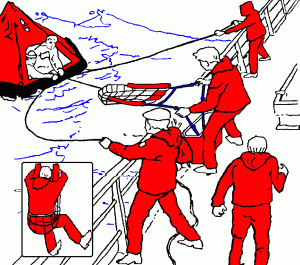Practical know-how concerning use of Markusnets

The MS Markusnet design is based on many years of development and experience. Every part of the unit has specific purpose to make the Markusnet most reliable and effective to retrieve man overboard in hazardous situations at sea, while the rescuer can stay on deck and manauver the unit.
THE MAIN PURPOSE OF THE MARKUSNET IS TO PROVIDE MANUAL MAN OVERBOARD RESCUE POSSIBILITIES
It is important to have in mind that the Markusnet is designed to use manually to lift one person at a time, from the water or life-raft, but can also be used to hoist person by crane, both in vertical and horizontal position.
It is also intended to provice in-water rescuer security and secure his way back onboard. To fasten helpless casualty in, to be hoisted up in horizontal position. To provide second security when there is a need to transport people from boat onto a ship in difficult situations.
THE MAN IN THE WATER LOOSES THE ABILITY TO THINK LOGICALLY AND IS LIKELY TO BE DANGEROUS TO A HELPER (IN-WATER RESCUER)
A great majority of those who fall into a cold sea, loose their ability to think logically, as the fear of the uncertain situation takes over natural way of thinking. Those who have experience in this matter know that such victim is not likely to pull a life-ring or chest loop over their head nor to pull a thing which seams to be a float barrier under their body. Such victim is likely to be dangerous to the in-water rescuer as he/she approaches him in the sea.
THE TWO MAIN ROLES OF THE THROW-LINE UNIT ARE, TO ACTIVATE THE WILL POWER OF THE MAN OVERBOARD AND TO BE SECURITY FOR THE IN-WATER RESCUER
The throw-line bag is designed to ease the throw and to catch the eye of the man in the sea and call for his reaction to pull himself into the net, where he can feel safe and secured.
After the man in the sea is in the net, the rescuers can lift the person secured up manually in seconds or hoist him with crane or other hoisting equipment at the rescue spot. The throw-line unit, is the bait in this sense, which helps the victim to seek into safety by himself.
The throw-line / safety-line has also another role. The in-water rescuer can, by fastening the chest-loop on the throw-bag around his chest, link himself to the rescue platform (quay or deck) with the attachment line hook, before he/she goes in to the water. By lowering the net into the sea, enough to fasten the victim in the net and by fastening lifting lines to the rescue platform, the in-water rescuer has both opened a realistic in-water rescue possiblity and secured his way back on board or onto a quay.


